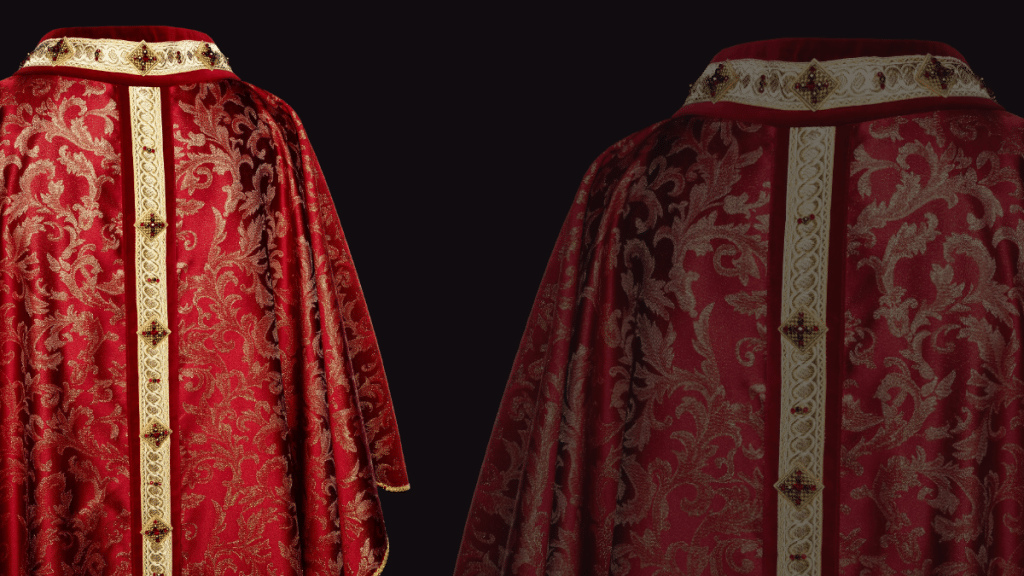Ecru, a colour often described as off-white, cream, or light beige, holds a special significance in the world of liturgical vestments. For centuries, it has been a popular choice for chasubles, the outermost vestment worn by priests during the celebration of Mass. This article explores the reasons behind the enduring popularity of ecru chasubles, their symbolic meaning, and what to consider when choosing one for yourself or your parish.
Symbolism and Meaning
The colour ecru carries a rich symbolism rooted in its neutral tone. Unlike stark white, which can sometimes appear sterile, ecru projects a sense of warmth and approachability. It is often associated with:
- Purity: Ecru, being a close relative of white, retains the association with purity, holiness, and divine light. It subtly symbolizes the purity of the celebrant’s intention and the sacredness of the liturgical actions.
- Humility: The soft, understated nature of ecru speaks to humility, a virtue central to Christian teachings. It avoids the ostentation often associated with brighter, more extravagant colours.
- Timelessness: Unlike trendy colours, ecru boasts a timeless quality that resonates with traditional liturgical practices. It remains a consistently elegant and appropriate choice year after year.
Versatility in Liturgical Use
One of the greatest advantages of an ecru chasuble is its versatility. While specific liturgical colours are prescribed for different seasons and feasts, ecru offers the following:
- Flexibility:It can be used throughout the liturgical year, making it a practical choice for parishes with limited vestment budgets. While not a replacement for specific colours, it is acceptable in circumstances where other colours are not available or when a lighter, simpler vestment is desired.
- Complementary: It pairs well with a variety of altar linens and other vestments. Its neutral nature means it will not clash with other liturgical colours, making it a safe and elegant choice.
- Graceful: Its understated elegance is always appropriate, lending a sense of reverence and solemnity to any service.
Choosing the Perfect Ecru Chasuble
The choice of material significantly impacts the look, feel, and longevity of an ecru chasuble. Common options include:
- Linen: Known for its breathability and natural texture, linen is a traditional choice. It drapes beautifully and is comfortable to wear, especially in warmer climates. However, it may require more ironing to maintain its crisp appearance.
- Polyester: Polyester blends are popular for their durability and wrinkle resistance. They are easy to care for and often more affordable than natural fibres.
- Silk: Silk provides a luxurious feel and beautiful sheen. It drapes exceptionally well but is typically the most expensive option and requires careful handling.
- Wool: Lightweight wool is another excellent option, providing warmth and breathability while having a beautiful, drapable texture.
Design and Embroidery
Ecru chasubles can vary greatly in design, from very simple to more elaborately decorated options. Consider these aspects:
- Embroidery: Many ecru chasubles feature delicate embroidery, often with religious symbols such as crosses, monograms, or wheat and grape motifs. The style and colour of embroidery can contribute to the overall look and feel of the vestment.
- Orphrey: The orphrey (a vertical band of fabric) is a decorative element that can be made from contrasting fabrics or embroidered. The design of the orphrey can add a touch of colour and elegance to an ecru chasuble.
- Cut and Style: Chasubles come in different cuts, such as Gothic, Roman, and Monastic, each offering a different drape and silhouette. The choice of cut often depends on personal preference and liturgical tradition.
- Neckline: The neckline can vary from a simple round neck to a more complex cowl neck. Comfort and personal preference will be the best guides when choosing this.
Craftsmanship and Quality
A well-made chasuble is an investment that can last for years. Pay attention to the following aspects:
- Stitching: Look for clean, tight stitching, which is a sign of quality craftsmanship. Reinforced seams are especially important for durability.
- Lining: A lined chasuble adds to its structure and prevents chafing. Quality lining material, often satin or cotton, will improve the wearability of the vestment.
- Fit: A properly fitting chasuble will drape well and allow freedom of movement during liturgical actions.
Storage
Proper storage will prolong the life of your ecru chasuble.
- Hanging: Hang your chasuble on a padded hanger to maintain its shape. Avoid storing it in direct sunlight, as this can fade the colour over time.
- Folding: If you must fold it, do so carefully and avoid creasing along the embroidered areas
Haftina USA: Crafting Liturgical Elegance
At haftinausa.com, we offer a wide selection of ecru chasubles crafted with the highest standards of quality and artistry. Our chasubles are available in various styles, materials, and designs, ensuring that you find the perfect vestment to enhance your liturgical celebrations. Browse our collection today and experience the timeless beauty and spiritual significance of a well-crafted ecru chasuble.
Our Commitment to Quality
We are dedicated to providing our customers with liturgical vestments that are not only beautiful but also durable and comfortable to wear. Each chasuble is made with meticulous attention to detail by skilled artisans who understand the significance of their craft.
